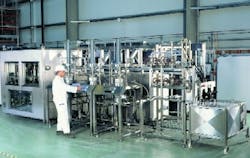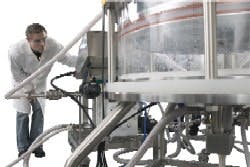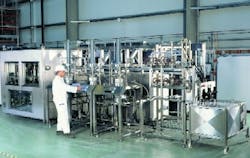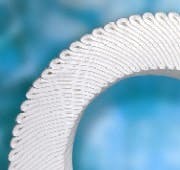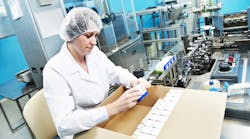- process integration and intensification;
- the use of compound filters during clarification;
- more efficient resin utilization (including reuse) and higher product recovery;
- alternative downstream strategies that employ membrane adsorbers, liquid-liquid separations, and of course, disposables.
A technician operates a Capto MMC column cation exchanger, which allows rapid protein purification from undiluted feedstock. Photo courtesy of GE Healthcare.
The company uses resin-impregnated microwells that serve as microcolumns for testing adsorption/desorption at varying pH, ionic strength and elution conditions. Optimizing the ion exchanger to do the work of two columns takes about one day and consumes only about one gram of product. Were finding the sweet spot for the anion exchange step, says Jeff Deetz, senior director for drug substance development.Other companies and vendors are catching on to micromethods for optimizing very large columns. Through its process proteomics collaboration with Ciphergen (Fremont, Calif.), Pall now offers high-throughput chromatography screening services for rapid process-scale chromatography methods development. Based on SELDI mass spectrometry, the service rapidly screens binding and elution conditions on the Ciphergen ProteinChip array coated with various adsorptive chromatography chemistries. This technique allows you to do in a few hours what previously took days or weeks with small columns, says Jerold Martin, Palls senior VP for scientific affairs.Since the workload of downstream steps depends on upstream productivity, bioprocessors must decide rather early how to deal with low-capacity stationary phases, and whether to use one column (with split batches) or multiple columns. Splitting batches to accommodate shortfalls in chromatography capacity introduces uncertainty into a process in that, simply, more things can go wrong.Shared resources such as buffer preparation tend to cause more than their share of bottlenecks during manufacturing. Each of the multiple columns used to purify proteins requires as many as a dozen buffers and washes, which throughout the manufacturing site are prepared in a limited number of vessels. Formulating these complex solutions ahead of time reduces buffer-related scheduling mishaps, but introduces additional storage-related costs (such as the need for steel tanks and additional floor space).The principal bottleneck issue here is scheduling, says Charlie Siletti, director for planning and scheduling applications at Intelligen (Scotch Plains, N.J.), which offers a process scheduling product, SchedulePro, to iron out such difficulties. Most manufacturers dont have the luxury of owning a dozen tanks for buffers.Even when confronted with delays arising from resource sharing, most processors fail to take the simple precaution of inserting slack time between operations, particularly between fermentation and capture chromatography. Batches that enter downstream operations late affect the timing of subsequent batches, Siletti notes.Stuck on youAffinity chromatography, long a trademark of bioprocessing, was originally developed to reduce chromatography steps. Todays affinity ligands include metal chelate, dye mimetics, proteins and immunoproteins in addition to more common protein A.Also included under the affinity category are product-specific custom affinity resins for nonantibody proteins. Such resins incorporate hydrophobic charge induction chromatography and small molecules that mimic native protein binding sites, similar to protein A mimetics, or other types of product-specific affinity proteins. Custom resins are costly, but may be affordable for large-volume bioproducts.Vendors have worked to make protein A ligands chemically inert and amenable to cleaning. GE Healthcares alkali-stabilized protein A matrix (MabSelect SuRe), introduced earlier this year, is one result of these efforts.Yet, there is keen interest in replacing protein A and other chromatography steps with less-expensive unit operations. Some lucky processors such as Abbott Laboratories have been able to eliminate affinity capture media altogether (see Abbott Streamlines Downstream Bioprocessing, below).In other cases, less-costly protein A-mimetic resins can be used, such as Palls HyperCel MAb-selective resins, which cost about one-third as much as protein A and are cleanable with concentrated caustic, as well as mimetic ligands offered by Affinity Chromatography Limited (Cambridge, U.K.), Prometic (Montréal) and other vendors.Small-Molecule Chromatography: A Hard SellConvincing small-molecule manufacturers to adopt column chromatography for production takes some doing. At large scale, small-molecule chromatography can be expensive and time-consuming. A large column generates huge volumes of solvent, creating fire hazards and the need for solvent recycling, and the large number of fractions eluting from large process columns impose an analytical burden resulting in long cycle times. Crystallization always beats chromatography, and by a lot, says Michael Kolb, Ph.D., VP of chemical development at Wyeth (Pearl River, N.Y.).Kolb cites capital costs for chromatography and solvent recovery, energy, and the safety and costs of working with large quantities of solvent as the principal hurdles. It would have to be a very valuable compound for us even to consider it, Kolb says. In more than 99% of cases, we can find a way to purify the compound through crystallization.Nevertheless, advocates say, there is something to be said for chromatography, particularly for compounds that arent amenable to crystallization. Continuous chromatography offers a number of manufacturing advantages and is already being used to manufacture several large-scale pharmaceuticals, including the anti-epilepsy drug Keppra (levetiracetam) made by UCB Pharma (Brussels) and Lexapro/Cipralex (escitalopram), produced by Forest Laboratories, New York and H. Lundbeck A/S, Copenhagen. Options include:
- Simulated moving bed (SMB) chromatography Developed in the 1960s as a continuous purification technique for the oil industry, SMB has since been adopted by food, chemicals and pharmaceuticals, and most recently, in biotech (Pharmaceutical Manufacturing, Nov./Dec. 2004, p. 27). SMB addresses several concerns of drugmakers with chromatography, and offers a number of advantages, using less solvent per unit of purified material, and offering better resolution than that of batch chromatography.
In the 1990s, Novasep (Boothwyn, Pa.) developed and introduced SMB to pharmaceutical companies. Its process-scale continuous SMB systems use multiple columns of up to one meter in diameter.
- Varicol (pictured above) Another Novasep process, it is said to be 20% more efficient than SMB. Where SMB units use four columns or zones that rely on counter-current movement of solid and liquid phases, Varicol combines cocurrent and countercurrent motion and requires one or two fewer columns than SMB to achieve similar performance. The method is particularly effective in the resolution of enantiomers from racemic mixtures.
Both Varicol and SMB are binary separators, which means that they are only capable of purifying mixtures of two components (exactly what is needed for racemate resolution). That is why compounds undergoing chiral chromatographic resolution are frequently purified by crystallization first to eliminate fast- and slow-eluting impurities.
Novasep also sells preparative and process high-performance liquid chromatography (HPLC), operating in batch mode, for small to large peptides using columns of up to 1.6 meters in diameter. The company has entered a biochromatography alliance with Rohm and Haas Co. (Philadelphia) to develop biomolecule separations based on high-performance resins. The collaboration has developed a few processes for peptides but has not yet tackled large molecules like MAbs.
Since the cost of discarding the undesirable enantiomer is so high, chiral chromatography only makes sense when chirality can be recycled through re-racemation and another pass through the chiral column. Recycling can up yields to 90% and above, provided the chiral intermediate does not racemize spontaneously. You have to think of chiral chromatography within a global synthetic pathway, says Jean Blehaut, president of parent company Novasep SA. - Recycle or steady state recycle chromatography This continuous method differs from SMB in several ways:
- it uses only one column instead of four;
- its capacity and throughput are somewhat lower;
- it is more at home in development labs or early research than in a manufacturing suite.
- it uses only one column instead of four;
Abbott Streamlines Downstream Bioprocessing Abbott Laboratories (North Chicago, Ill.) flagship purification platform for MAb purification uses cation exchange rather than affinity capture, changing the game for both feedstock and subsequent downstream steps. According to James Stout, Ph.D., group leader for purification, process sciences, the major hurdle in early downstream processing becomes host cell removal, followed by protein impurities that behave similarly to target molecules (perhaps a result of not using affinity capture). Abbott also encounters protein aggregation and fragmentation, host cell protein variability, and protein hazing and precipitation, in addition to the usual ongoing capacity issues. The advent of super-resins that bind 100 grams or more of protein per liter of resin, without compromising resolution or throughput, has helped harmonize upstream and downstream capacities. Abbott is also looking seriously at older unit operations such as crystallization, selective precipitation or liquid-liquid extraction to complement chromatography by cutting down process volumes, impurities or both. Abbott believes that process analytics will eventually help lessen the mismatch between upstream and downstream capacities. Process mapping and chromatography profiling for impurity removal can provide feedback for operating cell culture to reduce certain side-products. Certainly, chromatography is at the center of this assessment from both a processing/purification and analysis standpoint, Stout adds. Membrane adsorbers are part of a possible replacement strategy for traditional column chromatography, but a head-to-head comparison still favors chromatography, says Stout. |
Gottschalk, as well as his counterparts at Pall and other vendors, is very excited about membrane chromatography (MC), which is a cross between filtration and ion exchange and which delivers a good many of chromatographys purification capabilities with the high throughput and disposability of membrane filters.Membrane chromatography cartridges, also called membrane adsorbers, provide very rapid processing for dilute solutions, especially when both product and impurity are present at low concentration. Membrane adsorbers have caught on for polishing applications, to remove trace viruses, DNA and other impurities. A one-liter MC cartridge typically replaces 100 liters of anion-exchange resin.The membranes relatively low capacity makes them unsuitable for capture chromatography, although some vendors are pushing this application as well and end users are interested. A good protein A or ion-exchange resin can bind upwards of 70 grams of protein per liter of resin, which most membranes dont achieve. Ambitious processors have tried linking MC units in sequence to achieve column-like capacity, or quickly recycling through the same membrane.Pall claims its Mustang Q XT 5000 membrane adsorber, which binds 80 grams of albumin per liter of membrane volume, is already encroaching on niche product binding and capture applications. At five liters, Mustang cartridges adsorb up to about 400 grams of protein each. Since each cycle takes only a few minutes, this product achieves kilogram-scale binding within a reasonable time frame through multiple cycles. While this is not quite a ton-scale separation, it suggests a future direction for MC capability.
